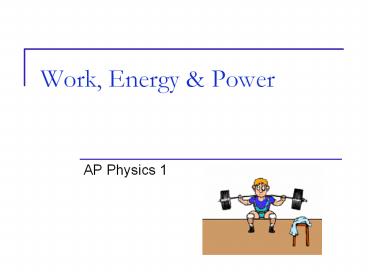Work, Energy - PowerPoint PPT Presentation
1 / 9
Title:
Work, Energy
Description:
Work, Energy & Power AP Physics 1 There are many different TYPES of Energy. Energy is expressed in JOULES (J) Energy can be expressed more specifically by using the ... – PowerPoint PPT presentation
Number of Views:171
Avg rating:3.0/5.0
Title: Work, Energy
1
Work, Energy Power
- AP Physics 1
2
There are many different TYPES of Energy.
- Energy is expressed in JOULES (J)
- Energy can be expressed more specifically by
using the term WORK(W)
Work The Scalar Dot Product between Force and
Displacement. So that means if you apply a force
on an object and it covers a displacement you
have supplied ENERGY or done WORK on that object.
3
Scalar Dot Product?
- A product is obviously a result of multiplying 2
numbers. A scalar is a quantity with NO
DIRECTION. So basically Work is found by
multiplying the Force times the displacement and
result is ENERGY, which has no direction
associated with it.
A dot product is basically a CONSTRAINT on the
formula. In this case it means that F and x MUST
be parallel. To ensure that they are parallel we
add the cosine on the end.
4
Work
The VERTICAL component of the force DOES NOT cause the block to move the right. The energy imparted to the box is evident by its motion to the right. Therefore ONLY the HORIZONTAL COMPONENT of the force actually creates energy or WORK.
When the FORCE and DISPLACEMENT are in the SAME DIRECTION you get a POSITIVE WORK VALUE. The ANGLE between the force and displacement is ZERO degrees. What happens when you put this in for the COSINE?
When the FORCE and DISPLACEMENT are in the OPPOSITE direction, yet still on the same axis, you get a NEGATIVE WORK VALUE. This negative doesn't mean the direction!!!! IT simply means that the force and displacement oppose each other. The ANGLE between the force and displacement in this case is 180 degrees. What happens when you put this in for the COSINE?
When the FORCE and DISPLACEMENT are PERPENDICULAR, you get NO WORK!!! The ANGLE between the force and displacement in this case is 90 degrees. What happens when you put this in for the COSINE?
5
Example
- A 15 kg crate is moved along a horizontal floor
by a worker who is pulling on a rope that makes a
300 angle above the horizontal. The tension in
the rope is 70 N and the crate moves a distance
of 10 m. The coefficient of friction between the
floor and crate is 0.40. - How much work is done by gravity and the normal
force? - How much work is done by the worker?
- How much work is done by friction?
- Is the crate speeding up or slowing down? Justify.
6
Example
- A box slides down an inclined plane (370). The
mass of the block is 35 kg, the coefficient of
friction between the box and ramp is 0.30, and
the length of the ramp is 8 m. - How much work is done by gravity?
- How much work is done by the normal force?
- How much work is done by friction?
- What is the total work done?
7
The Work Energy Theorem
- Up to this point we have learned Kinematics and
Newton's Laws. Let 's see what happens when we
apply BOTH to our new formula for WORK!
- We will start by applying Newton's second law!
- Using Kinematic 3!
- An interesting term appears called KINETIC
ENERGY or the ENERGY OF MOTION!
8
The Work Energy Theorem
- And so what we really have is called the
WORK-ENERGY THEOREM. It basically means that if
we impart work to an object it will undergo a
CHANGE in speed and thus a change in KINETIC
ENERGY. Since both WORK and KINETIC ENERGY are
expressed in JOULES, they are EQUIVALENT TERMS!
" The net WORK done on an object is equal to the
change in kinetic energy of the object."
9
Example WFxcosq
- A 70 kg base-runner begins to slide into second
base when moving at a speed of 4.0 m/s. The
coefficient of kinetic friction between his
clothes and the earth is 0.70. He slides so that
his speed is zero just as he reaches the base (a)
How much work is done on the runner as he slides?
(b) How far does he slide?
-560 J
480.2 N
1.17 m































